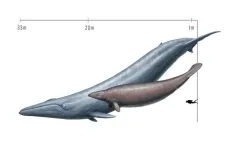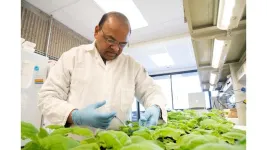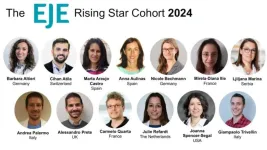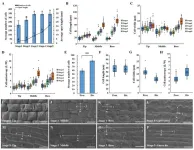(Press-News.org) A 30 million year-old fossil whale may not be the heaviest animal of all time after all, according to a new analysis by paleontologists at UC Davis and the Smithsonian Institution. The new analysis puts Perucetus colossus back in the same weight range as modern whales and smaller than the largest blue whales ever recorded. The work is published Feb. 29 in PeerJ.
A fossil skeleton of Perucetus was discovered in Peru and described in a paper in Nature last year. The animal lived about 39 million years ago and belonged to an extinct group of early whales called the basilosaurids.
Perucetus’ bones are unusually dense. Mammal bones usually have a solid exterior and are spongy or hollow in the center. Some animals have more of the center filled in with solid bone, making them dense and heavy. In aquatic animals, heavy bones can offset buoyancy from body fat and blubber, allowing the animal to maintain neutral buoyancy in water or – in the case of the hippopotamus – to walk on river beds.
The fossil whale bones have both extensive in-filling and extra growth of bone on the outside as well, a condition called pachyostosis also seen in some modern aquatic mammals, such as manatees.
Based on a series of assumptions, the original authors (Giovanni Bianucci at the University of Pisa, Italy and colleagues) estimated a body mass for Perucetus of 180 metric tons (ranging from 85 to 340 metric tons). This would make Perucetus as heavy as, or heavier than the biggest blue whales known, even though it is considerably shorter at 17 meters long compared to a blue whale at about 30 meters.
How to weigh a whale?
Professor Ryosuke Motani, a paleobiologist at the UC Davis Department of Earth and Planetary Sciences, said that these estimates would make Perucetus impossibly dense.
“It would have been a job for the whale to stay at the surface, or even to leave the sea bottom--it would have required continuous swimming against the gravity to do anything in the water,” Motani said.
Motani and Nick Pyenson at the Smithsonian Institute National Museum of Natural History reexamined the assumptions used to make those estimates.
The first problem is that Bianucci et al used the fossil bones to estimate the weight of the skeleton, then extrapolated to the weight of the entire animal, assuming that the skeletal and non-skeletal mass would scale at the same rate with increasing body size. But measurements of other animals show this is not the case, Motani and Pyenson argue.
The original estimates also overestimated how much overall body mass increases as a result of pachyostosis. But evidence from manatees shows that their bodies are relatively light relative to their skeletal mass.
Motani and Pyenson estimate that the 17-meter long Perucetus weighed in at 60 to 70 tons, considerably less than the known weights of blue whales. A Perucetus that grew to 20 meters could weigh over 110 tons, still well short of the largest blue whales at 270 tons.
“The new weight allows the whale to come to the surface and stay there while breathing and recovering from a dive, like most whales do,” Motani said.
Paleontologists have not yet uncovered a skull or teeth of Perucetus, so it is hard to tell what it ate. Sustaining a huge body takes a lot of food. Bianucci et al suggested that Perucetus might have browsed on coastal fish and shellfish, or scavenged carcases, as some sharks do. The new slimmed-down size estimate puts Perucetus in a similar range to sperm whales (80 tons, 20 meters long), which hunt large prey such as giant squid.
END
Slimming down a colossal fossil whale
2024-02-29
ELSE PRESS RELEASES FROM THIS DATE:
Better neutron mirrors can reveal the inner secrets of matter
2024-02-29
Improved neutron mirrors can increase the efficiency of material analysis in neutron sources such as the ESS, which is being built outside Lund, Sweden. The improved mirror has been developed by researchers at Linköping University by coating a silicon plate with extremely thin layers of iron and silicon mixed with boron carbide. Their study has been published in the journal Science Advances.
“Instead of increasing the power on the neutron source, which is extremely expensive, it’s better to focus on improving optics,” says Fredrik Eriksson, researcher at the Thin Film Physics Division at Linköping University.
Together with protons, neutrons ...
Astronomers reveal a new link between water and planet formation
2024-02-29
Researchers have found water vapour in the disc around a young star exactly where planets may be forming.
Water is a key ingredient for life on Earth and is also thought to play a significant role in planet formation, yet, until now, astronomers have never been able to map how water is distributed in a stable, cool disc — the type of disc that offers the most favourable conditions for planets to form around stars.
For the first time, astronomers have weighed the amount of water vapour around a typical planet-forming star.
The new findings were made possible thanks to the Atacama Large Millimeter/submillimeter Array (ALMA) - a collection of telescopes ...
Plant biologists identify promising new fungicides
2024-02-29
A promising new fungicide to fight devastating crop diseases has been identified by researchers at the University of California, Davis. The chemical, ebselen, prevented fungal infections in apples, grapes, strawberries, tomatoes and roses and improved symptoms of pre-existing fungal infection in rice.
Fungal pathogens account for almost a quarter of global crop losses. In the United States, these losses amount to around $150 billion per year. However, fungicide development has been slow for the past 50 years, largely because researchers have had difficulty identifying molecular pathways to target. In a new study published Feb. 29 in ...
Researchers uncover a potential genetic marker associated with better survival outcomes in patients with head and neck cancer
2024-02-29
FINDINGS
Researchers from the UCLA Health Jonsson Comprehensive Cancer Center show for the first time that a gene usually linked to giant axonal neuropathy, a rare and severe neurological condition, also plays a role in inhibiting aggressive tumor cell growth in head and neck cancers.
The team found when the specific genetic variant (GAN gene exon 8 SNP T allele) of the GAN gene isn't present, it leads to the production of certain proteins that make cancer cells more likely to spread and become resistant to treatment.
These findings suggest that the presence of the genetic variant and higher expression of the GAN gene product gigaxonin may contribute ...
European Society for Endocrinology’s European Journal of Endocrinology announces “Rising Stars” in endocrine research for 2024-26
2024-02-29
Thirteen exceptional endocrine researchers from across Europe and the US have been selected as the 2024-26 cohort of the EJE Rising Star Editorial Board by the European Journal of Endocrinology (EJE), a journal published by the European Society of Endocrinology (ESE).
This prestigious opportunity is given to individuals selected by EJE Editors who show promise, achievement and trajectory as leading clinical and translational researchers in endocrinology, with high potential to serve as future editors of EJE.
Through the Rising Stars Programme, awardees are granted the following:
membership ...
Hai-quan Huang's research team at Southwest Forestry University has revealed the cellular and molecular basis of the spur development in Impatiens uliginosa
2024-02-29
As an important reproductive organ of angiosperms, flowers have clear purposefulness and adaptive significance in their various characteristics. As a typical floral evolutionary feature, the floral spur is a tubular structure extending from the petal, which has undergone several independent evolutions in angiosperms (e.g., Impatiens, Aquilegia, Linaria, etc.). Meanwhile, it plays a vital role in the pollination process because of its properties of secreting and storing nectar. In addition, the morphology (length, diameter, degree of distortion), ...
New research reveals that lockdowns had an impact on gut microbes and allergies in newborns
2024-02-29
29 February 2024: Lockdowns imposed during the COVID-19 pandemic had an impact on the gut microbiome development of babies born during these periods according to new research from RCSI University of Medicine and Health Sciences, Children’s Health Ireland and APC Microbiome Ireland (APC), a world leading SFI Research Centre, based in University College Cork.
Our gut microbiome, an ecosystem of microbes that live in our digestive tract, plays an essential role in human health. The study published in Allergy is the first to specifically explore the gut health of newborns in the pandemic. ...
Seeing the wood for the trees: how archaeologists use hazelnuts to reconstruct ancient woodlands
2024-02-29
If we could stand in a landscape that our Mesolithic ancestors called home, what would we see around us? Scientists have devised a method of analyzing preserved hazelnut shells to tell us whether the microhabitats around archaeological sites were heavily forested or open and pasture-like. This could help us understand not only what a local environment looked like thousands of years ago, but how humans have impacted their habitats over time.
“By analyzing the carbon in hazelnuts recovered from archaeological sites in southern Sweden, from Mesolithic hunter-gatherer ...
EU-funded Biodiversity Community Integrated Knowledge Library (BiCIKL) project sums up outcomes and future prospects at a Final GA in Cambridge
2024-02-29
The city of Cambridge and the Wellcome Campus hosted the Final General Assembly of the EU-funded project BiCIKL (acronym for Biodiversity Community Integrated Knowledge Library): a 36-month endeavour that saw 14 member institutions and 15 research infrastructures representing diverse actors from the biodiversity data realm come together to improve bi-directional links between different platforms, standards, formats and scientific fields. Consortium members who could not attend the meeting in Cambridge joined the meeting remotely.
The ...
Detailed study demonstrates how pulse oximeters significantly overestimate oxygen readings in people with darker skin tones
2024-02-29
Pulse oximeters – one of the most common medical devices used in global healthcare – can provide significantly overestimated oxygen saturation readings in people with darker skin tones, according to the most comprehensive study ever to explore the issue.
Published in the British Journal of Anaesthesia, the new study is based on a systematic review of previous research into the use of the devices, and examined 44 studies dating from the mid-1970s to the present day.
In the course of that, researchers assessed more than 733,000 oxygen saturation readings taken from over 222,000 people – including almost ...






